Spatiotemporal Dynamics of Drought–Flood Abrupt Alternations and Their Delayed Effects on Vegetation Growth in Heilongjiang River Basin
Abstract
1. Introduction
2. Research Area and Data
2.1. Location of the Study Area
2.2. Data Sources
2.2.1. Runoff Data
2.2.2. Normalized Difference Vegetation Index (NDVI)
2.2.3. Unified Data Resolution and Analysis Scale Selection
3. Method
3.1. Community Water Model (CWatM)
3.2. Drought–Flood Abrupt Alteration Index (DFAAI)
3.3. Wavelet Analysis
3.4. Pearson’s Correlation Analysis
4. Results
4.1. Spatiotemporal Analysis of DFAAs
4.1.1. Spatial Distribution of DFAAs
4.1.2. Time Distribution of DFAA
4.2. Analysis of NDVI Evolution Law
4.2.1. Annual Variation
4.2.2. Interannual Variation
4.3. Response of NDVI to DFAAE
5. Discussion
5.1. Direct Effects of DFAAE on Vegetation Growth
5.2. Feedback Mechanism of Vegetation Growth Change to DFAAs
5.3. Uncertainty of CWatM Simulation
6. Conclusions
- (1)
- From 1970 to 2019, the DTF events were most frequent in the SHR and least frequent in the AmgonR, with an upward trend (3.51%/decade). The FTD events decreased (4.52%/decade) over time, were more frequent in northern regions like the ErgunaR and the ShilkaR, and less frequent in eastern areas like the JieyaR and the BreaR. Temporally, events peaked in spring and summer, were concentrated in the south in autumn, and were least frequent in winter. High-frequency areas expanded from the north in the 1970s–1980s into the entire basin. From 2010 to 2019, the DTF events were concentrated in the south and east, while the FTD events showed a decline in the northern high-frequency areas.
- (2)
- Annual NDVI values were lowest in January, highest in July, and close to 0 in winter. Vegetation coverage was greatest in summer. Southern areas like SHR and the UssuriR had relatively higher NDVI values all year. Northern regions, like ErgunaR, were more climate restricted. From 2000 to 2019, vegetation growth markedly increased. The NDVI values were lower from 2000 to 2009, especially in the northern and central high altitudes, but rose significantly from 2010 to 2019, with a reduction in low-value areas and an expansion of high-value areas.
- (3)
- Wavelet Coherence analysis revealed that drought and flood events have a 1–4-month lag effect on vegetation. The positive and negative correlations were most significant in the spring–summer period with a 3–4-month lag. In the summer–autumn period, the peak lagged by 3 months.
Author Contributions
Funding
Data Availability Statement
Acknowledgments
Conflicts of Interest
References
- Bi, W.; Weng, B.; Yan, D.; Zhang, D.; Liu, C.; Shi, X.; Jing, L.; Yan, S.; Wang, H. Response of summer maize growth to drought-flood abrupt alternation. Front. Earth Sci. 2023, 11, 1086769. [Google Scholar] [CrossRef]
- Liu, T.T.; Zhu, X.F.; Tang, M.X.; Guo, C.H.; Lu, D.Y. Multi-model ensemble bias-corrected precipitation dataset and its application in identification of drought-flood abrupt alternation in China. Atmos. Res. 2024, 307, 107481. [Google Scholar] [CrossRef]
- Shi, W.Z.; Huang, S.Z.; Liu, D.F.; Huang, Q.; Han, Z.M.; Leng, G.Y.; Wang, H.; Liang, H.; Li, P.; Wei, X.T. Drought-flood abrupt alternation dynamics and their potential driving forces in a changing environment. J. Hydrol. 2021, 597, 126179. [Google Scholar] [CrossRef]
- Bi, W.; Li, M.; Weng, B.; Yan, D.; Dong, Z.; Feng, J.; Wang, H. Drought-flood abrupt alteration events over China. Sci. Total Environ. 2023, 875, 162529. [Google Scholar] [CrossRef]
- Zhou, W.; Liu, D.; Zhang, J.; Jiang, S.; Xing, S.; Wang, J.; Cheng, Y.; Chen, N. Identification and frequency analysis of drought–flood abrupt alternation events using a daily-scale standardized weighted average of the precipitation index. Front. Environ. Sci. 2023, 11, 1142259. [Google Scholar] [CrossRef]
- Chakraborty, T.; Lee, X. A simplified urban-extent algorithm to characterize surface urban heat islands on a global scale and examine vegetation control on their spatiotemporal variability. Int. J. Appl. Earth Obs. Geoinf. 2019, 74, 269–280. [Google Scholar] [CrossRef]
- Shi, X.L.; Yang, Y.Q.; Yuan, Z.; Ding, H.; Zhang, Y.; Chen, J.J.; Shi, M.Q. Integrating SWAP and SIF anomaly to assess the responses of vegetation to the drought-flood abrupt alternation in the middle and lower reaches of the Yangtze River basin, China. J. Hydrol. Reg. Stud. 2024, 52, 101726. [Google Scholar] [CrossRef]
- Qian, L.; Meng, H.Y.; Chen, X.H.; Tang, R. Evaluating agricultural drought and flood abrupt alternation: A case study of cotton in the middle-and-lower Yangtze River, China. Agric. Water Manag. 2023, 283, 108313. [Google Scholar] [CrossRef]
- Huang, J.; Hu, T.; Yasir, M.; Gao, Y.; Chen, C.; Zhu, R.; Wang, X.; Yuan, H.; Yang, J.J.E.; Botany, E. Root growth dynamics and yield responses of rice (Oryza sativa L.) under drought—Flood abrupt alternating conditions. Environ. Exp. Bot. 2019, 157, 11–25. [Google Scholar] [CrossRef]
- Bi, W.X.; Weng, B.S.; Yan, D.H.; Wang, M.K.; Wang, H.; Wang, J.J.; Yan, H.L. Effects of drought-flood abrupt alternation on phosphorus in summer maize farmland systems. Geoderma 2020, 363, 114147. [Google Scholar] [CrossRef]
- Bi, W.; Weng, B.; Yan, D.; Wang, M.; Wang, H.; Jing, L.; Yan, S. Soil phosphorus loss increases under drought-flood abrupt alternation in summer maize planting area. Agric. Water Manag. 2022, 262, 107426. [Google Scholar] [CrossRef]
- Zhu, J.; Li, A.; Zhang, J.; Sun, C.; Tang, G.; Chen, L.; Hu, J.; Zhou, N.; Wang, S.; Zhou, Y.J.E.; et al. Effects of nitrogen application after abrupt drought-flood alternation on rice root nitrogen uptake and rhizosphere soil microbial diversity. Environ. Exp. Bot. 2022, 201, 105007. [Google Scholar] [CrossRef]
- Zhu, R.; Wu, F.; Zhou, S.; Hu, T.; Huang, J.; Gao, Y. Cumulative effects of drought–flood abrupt alternation on the photosynthetic characteristics of rice. Environ. Exp. Bot. 2020, 169, 103901. [Google Scholar] [CrossRef]
- Shi, W.; Huang, S.; Zhang, K.; Liu, B.; Liu, D.; Huang, Q.; Fang, W.; Han, Z.; Chao, L. Quantifying the superimposed effects of drought-flood abrupt alternation stress on vegetation dynamics of the Wei River Basin in China. J. Hydrol. 2022, 612, 128105. [Google Scholar] [CrossRef]
- Liu, Y.; Shan, F.; Yue, H.; Wang, X.; Fan, Y. Global analysis of the correlation and propagation among meteorological, agricultural, surface water, and groundwater droughts. J. Environ. Manag. 2023, 333, 117460. [Google Scholar] [CrossRef]
- Weng, X.; Zhu, J.; Wang, D.; Chen, H.; Wang, S.; Qing, Y.J.G. Natural Hazards; Risk. Exploring the relationship between drought-flood abrupt alternation and soil erosion over Guangdong, China through a convection-permitting model. Geomat. Nat. Hazards Risk 2024, 15, 2383779. [Google Scholar] [CrossRef]
- Li, X.H.; Yuan, C.Y.; Sun, T.; Fan, H.X. Identifying the spatiotemporal patterns of drought-flood alternation based on IMERG product in the humid subtropical Poyang Lake basin, China. J. Hydrol.-Reg. Stud. 2024, 54, 101912. [Google Scholar] [CrossRef]
- Li, X.H.; Zhang, Q.; Zhang, D.; Ye, X.C. Investigation of the drought-flood abrupt alternation of streamflow in Poyang Lake catchment during the last 50 years. Hydrol. Res. 2017, 48, 1402–1417. [Google Scholar] [CrossRef]
- Ren, J.X.; Wang, W.G.; Wei, J.; Li, H.B.; Li, X.L.; Liu, G.S.; Chen, Y.L.; Ye, S.L. Evolution and prediction of drought-flood abrupt alternation events in Huang-Huai-Hai River Basin, China. Sci. Total Environ. 2023, 869, 161707. [Google Scholar] [CrossRef]
- Wang, L.; Guo, S.L.; Wang, J.; Chen, Y.B.; Qiu, H.; Zhang, J.; Wei, X.J. A novel multi-scale standardized index analyzing monthly to sub-seasonal drought-flood abrupt alternation events in the Yangtze River basin. J. Hydrol. 2024, 633, 130999. [Google Scholar] [CrossRef]
- Yang, P.; Zhang, S.Q.; Xia, J.; Zhan, C.S.; Cai, W.; Wang, W.Y.; Luo, X.G.; Chen, N.C.; Li, J. Analysis of drought and flood alternation and its driving factors in the Yangtze River Basin under climate change. Atmos. Res. 2022, 270, 106087. [Google Scholar] [CrossRef]
- Song, X.Y.; Lei, X.P.; Ma, R.; Hou, J.Z.; Liu, W.B. Spatiotemporal variation and multivariate controls of short-cycle drought-flood abrupt alteration: A case in the Qinling-Daba Mountains of China. Int. J. Climatol. 2023, 43, 4756–4769. [Google Scholar] [CrossRef]
- Chen, H.; Wang, S.; Zhu, J.; Zhang, B. Projected Changes in Abrupt Shifts Between Dry and Wet Extremes Over China Through an Ensemble of Regional Climate Model Simulations. J. Geophys. Res.-Atmos. 2020, 125, e2020JD033894. [Google Scholar] [CrossRef]
- Zhang, Y.Q.; You, Q.L.; Ullah, S.; Chen, C.C.; Shen, L.C.; Liu, Z. Substantial increase in abrupt shifts between drought and flood events in China based on observations and model simulations. Sci. Total Environ. 2023, 876, 162822. [Google Scholar] [CrossRef]
- Bai, X.; Zhao, C.; Tang, Y.; Zhang, Z.; Yang, B.; Wang, Z. Identification, physical mechanisms and impacts of drought–flood abrupt alternation: A review. Front. Earth Sci. 2023, 11, 1203603. [Google Scholar] [CrossRef]
- Burek, P.; Satoh, Y.; Kahil, T.; Tang, T.; Greve, P.; Smilovic, M.; Guillaumot, L.; Zhao, F.; Wada, Y. Development of the Community Water Model (CWatM v1.04)—A high-resolution hydrological model for global and regional assessment of integrated water resources management. Geosci. Model Dev. 2020, 13, 3267–3298. [Google Scholar] [CrossRef]
- Burek, P.; Smilovic, M.; Guillaumot, L.; de Bruijn, J.; Greve, P.; Satoh, Y.; Islaam, A.; Virgen-Urcelay, A.; Tang, T.; Kahil, T.; et al. Community Water Model CWatM Manual; IIASA: Laxenburg, Austria, 2020. [Google Scholar]
- Hinton, R.; Smilovic, M.; Fridman, D.; Willaarts, B.; Banda, L.; Macleod, K.; Troldborg, M.; Kalin, R. A stakeholder driven, holistic water resources model for Malawi: Applying the CWatM hydrological model. In Proceedings of the European Geosciences Union General Assembly 2024 (EGU24), Vienna, Austria, 14–19 April 2024; p. 5783. [Google Scholar]
- Kling, H.; Fuchs, M.; Paulin, M. Runoff conditions in the upper Danube basin under an ensemble of climate change scenarios. J. Hydrol. 2012, 424–425, 264–277. [Google Scholar] [CrossRef]
- Wu, Z.; Li, J.; He, J.; Jiang, Z. Large-scale atmospheric singularities and summer long-cycle droughts-floods abrupt alternation in the middle and lower reaches of the Yangtze River. Chin. Sci. Bull. 2006, 51, 2027–2034. [Google Scholar] [CrossRef]
- Labat, D. Recent advances in wavelet analyses: Part 1. A review of concepts. J. Hydrol. 2005, 314, 275–288. [Google Scholar] [CrossRef]
- Grinsted, A.; Moore, J.C.; Jevrejeva, S. Application of the cross wavelet transform and wavelet coherence to geophysical time series. Nonlinear Process. Geophys. 2004, 11, 561–566. [Google Scholar] [CrossRef]
- Torrence, C.; Compo, G.P. A Practical Guide to Wavelet Analysis. Bull. Am. Meteorol. Soc. 1998, 79, 61–78. [Google Scholar] [CrossRef]
- Hu, W.; Si, B. Improved partial wavelet coherency for understanding scale-specific and localized bivariate relationships in geosciences. Hydrol. Earth Syst. Sci. 2021, 25, 321–331. [Google Scholar] [CrossRef]
- Shi, L.L.; Wang, Y.Y.; Jia, Y.F.; Lu, C.; Lei, G.C.; Wen, L. Vegetation Cover Dynamics and Resilience to Climatic and Hydrological Disturbances in Seasonal Floodplain: The Effects of Hydrological Connectivity. Front. Plant Sci. 2017, 8, 2196. [Google Scholar] [CrossRef] [PubMed]
- Huang, J.P.; Yu, H.P.; Guan, X.D.; Wang, G.Y.; Guo, R.X. Accelerated dryland expansion under climate change. Nat. Clim. Change 2016, 6, 166–171. [Google Scholar] [CrossRef]
- Anyamba, A.; Tucker, C.J. Analysis of Sahelian vegetation dynamics using NOAA-AVHRR NDVI data from 1981–2003. J. Arid. Environ. 2005, 63, 596–614. [Google Scholar] [CrossRef]
- Bi, W.; Wang, M.; Weng, B.; Yan, D.; Yuheng, Y.; Wang, J. Effects of Drought-Flood Abrupt Alternation on the Growth of Summer Maize. Atmosphere 2019, 11, 21. [Google Scholar] [CrossRef]
- Zuo, X.; Li, X.; Yue, P.; Guo, A.; Yue, X.; Xu, C.; Knapp, A.K.; Smith, M.D.; Luo, W.; Allington, G.R.H.; et al. Drought-driven shifts in relationships between plant biodiversity and productivity in temperate steppes. Funct. Ecol. 2022, 36, 2917–2928. [Google Scholar] [CrossRef]
- Van den Hoof, C.; Lambert, F. Mitigation of drought negative effect on ecosystem productivity by vegetation mixing. J. Geophys. Res. Biogeosci. 2016, 121, 2667–2683. [Google Scholar] [CrossRef]
- Borisade, T.V.; Odiwe, A.I.; Akinwumiju, A.S.; Uwalaka, N.O.; Orimoogunje, O.O. Biodiversity. Impact of flooding frequency on the diversity and structures of riparian forests in Southwestern, Nigeria. Earth Hist. Biodivers. 2025, 3, 100018. [Google Scholar]
- Fischer, F.M.; Wright, A.J.; Eisenhauer, N.; Ebeling, A.; Roscher, C.; Wagg, C.; Weigelt, A.; Weisser, W.W.; Pillar, V.D. Plant species richness and functional traits affect community stability after a flood event. Philos. Trans. R. Soc. B Biol. Sci. 2016, 371, 20150276. [Google Scholar] [CrossRef]
- Kumar, S.; Sachdeva, S.; Bhat, K.; Vats, D.S. Plant Responses to Drought Stress: Physiological, Biochemical and Molecular Basis. Biotic and Abiotic Stress Tolerance in Plants; Springer: Singapore, 2018; pp. 1–25. [Google Scholar]
- Blom, C.W.P.M.; Voesenek, L.A.C.J. Flooding: The survival strategies of plants. Trends Ecol. Evol. 1996, 11, 290–295. [Google Scholar] [CrossRef] [PubMed]
- Yang, Y.; Weng, B.; Bi, W.; Xu, T.; Yan, D.; Ma, J. Climate Change Impacts on Drought-Flood Abrupt Alternation and Water Quality in the Hetao Area, China. Water 2019, 11, 652. [Google Scholar] [CrossRef]
- Jackisch, C.; Knoblauch, S.; Blume, T.; Zehe, E.; Hassler, S.K. Estimates of tree root water uptake from soil moisture profile dynamics. Biogeosciences 2020, 17, 5787–5808. [Google Scholar] [CrossRef]
- Spracklen, D.V.; Arnold, S.R.; Taylor, C.M. Observations of increased tropical rainfall preceded by air passage over forests. Nature 2012, 489, 282–285. [Google Scholar] [CrossRef]
- Feng, X.M.; Fu, B.J.; Piao, S.; Wang, S.H.; Ciais, P.; Zeng, Z.Z.; Lü, Y.H.; Zeng, Y.; Li, Y.; Jiang, X.H.; et al. Revegetation in China’s Loess Plateau is approaching sustainable water resource limits. Nat. Clim. Change 2016, 6, 1019–1022. [Google Scholar] [CrossRef]
- Zeng, N.; Neelin, J.D.; Lau, K.M.; Tucker, C.J. Enhancement of Interdecadal Climate Variability in the Sahel by Vegetation Interaction. Science 1999, 286, 1537–1540. [Google Scholar] [CrossRef]
- Peng, D.; Wu, C.; Zhang, B.; Huete, A.; Zhang, X.; Sun, R.; Lei, L.; Huang, W.; Liu, L.; Liu, X.; et al. The Influences of Drought and Land-Cover Conversion on Inter-Annual Variation of NPP in the Three-North Shelterbelt Program Zone of China Based on MODIS Data. PLoS ONE 2016, 11, e0158173. [Google Scholar] [CrossRef]
- Malhi, Y.; Roberts, J.T.; Betts, R.A.; Killeen, T.J.; Li, W.; Nobre, C.A. Climate Change, Deforestation, and the Fate of the Amazon. Science 2008, 319, 169–172. [Google Scholar] [CrossRef] [PubMed]
- Ruíz-García, V.H.; Borja de la Rosa, M.A.; Gómez-Díaz, J.D.; Asensio-Grima, C.; Matías-Ramos, M.; Monterroso-Rivas, A.I. Forest Fires, Land Use Changes and Their Impact on Hydrological Balance in Temperate Forests of Central Mexico. Water 2022, 14, 383. [Google Scholar] [CrossRef]
- Chaturvedi, R.K.; Gopalakrishnan, R.; Jayaraman, M.; Bala, G.; Joshi, N.; Sukumar, R.; Ravindranath, N.H. Impact of climate change on Indian forests: A dynamic vegetation modeling approach. Mitig. Adapt. Strateg. Glob. Change 2011, 16, 119–142. [Google Scholar] [CrossRef]
- Müller Schmied, H.; Eisner, S.; Franz, D.; Wattenbach, M.; Portmann, F.T.; Flörke, M.; Döll, P. Sensitivity of simulated global-scale freshwater fluxes and storages to input data, hydrological model structure, human water use and calibration. Hydrol. Earth Syst. Sci. 2014, 18, 3511–3538. [Google Scholar] [CrossRef]
- Shah, D.; Shah, H.L.; Dave, H.M.; Mishra, V. Contrasting influence of human activities on agricultural and hydrological droughts in India. Sci. Total Environ. 2021, 774, 144959. [Google Scholar] [CrossRef]
- Guillaumot, L.; Smilovic, M.; Burek, P.; de Bruijn, J.; Greve, P.; Kahil, T.; Wada, Y. Coupling a large-scale hydrological model (CWatM v1.1) with a high-resolution groundwater flow model (MODFLOW 6) to assess the impact of irrigation at regional scale. Geosci. Model Dev. 2022, 15, 7099–7120. [Google Scholar] [CrossRef]
- Kushwaha, A.P.; Tiwari, A.D.; Dangar, S.; Shah, H.; Mahto, S.S.; Mishra, V. Multimodel assessment of water budget in Indian sub-continental river basins. J. Hydrol. 2021, 603, 126977. [Google Scholar] [CrossRef]
- Hanus, S.; Schuster, L.; Burek, P.; Maussion, F.; Wada, Y.; Viviroli, D. Coupling a large-scale glacier and hydrological model (OGGM v1.5.3 and CWatM V1.08)—Towards an improved representation of mountain water resources in global assessments. Geosci. Model Dev. 2024, 17, 5123–5144. [Google Scholar] [CrossRef]
- Eyring, V.; Bony, S.; Meehl, G.A.; Senior, C.A.; Stevens, B.; Stouffer, R.J.; Taylor, K.E. Overview of the Coupled Model Intercomparison Project Phase 6 (CMIP6) experimental design and organization. Geosci. Model Dev. 2016, 9, 1937–1958. [Google Scholar] [CrossRef]
- Dione, P.M.; Faye, C.; Mohamed, A.; Alarifi, S.S.; Mohammed, M.A. Assessment of the impact of climate change on current and future flows of the ungauged Aga-Foua-Djilas watershed: A comparative study of hydrological models CWatM under ISIMIP and HMF-WA. Appl. Water Sci. 2024, 14, 163. [Google Scholar] [CrossRef]
- Cheng, W.; Feng, Q.; Xi, H.; Yin, X.; Cheng, L.; Sindikubwabo, C.; Zhang, B.; Chen, Y.; Zhao, X. Modeling and assessing the impacts of climate change on groundwater recharge in endorheic basins of Northwest China. Sci. Total Environ. 2024, 918, 170829. [Google Scholar] [CrossRef]
- de Bruijn, J.A.; Smilovic, M.; Burek, P.; Guillaumot, L.; Wada, Y.; Aerts, J. GEB v0.1: A large-scale agent-based socio-hydrological model-simulating10 million individual farming households in a fully distributed hydrological model. Geosci. Model Dev. 2023, 16, 2437–2454. [Google Scholar] [CrossRef]
- He, Y.F.; Xiong, J.H.; Guo, S.L.; Zhong, S.R.; Yu, C.T.; Ma, S.G. Using Multi-Source Data to Assess the Hydrologic Alteration and Extremes under a Changing Environment in the Yalong River Basin. Water 2023, 15, 1357. [Google Scholar] [CrossRef]

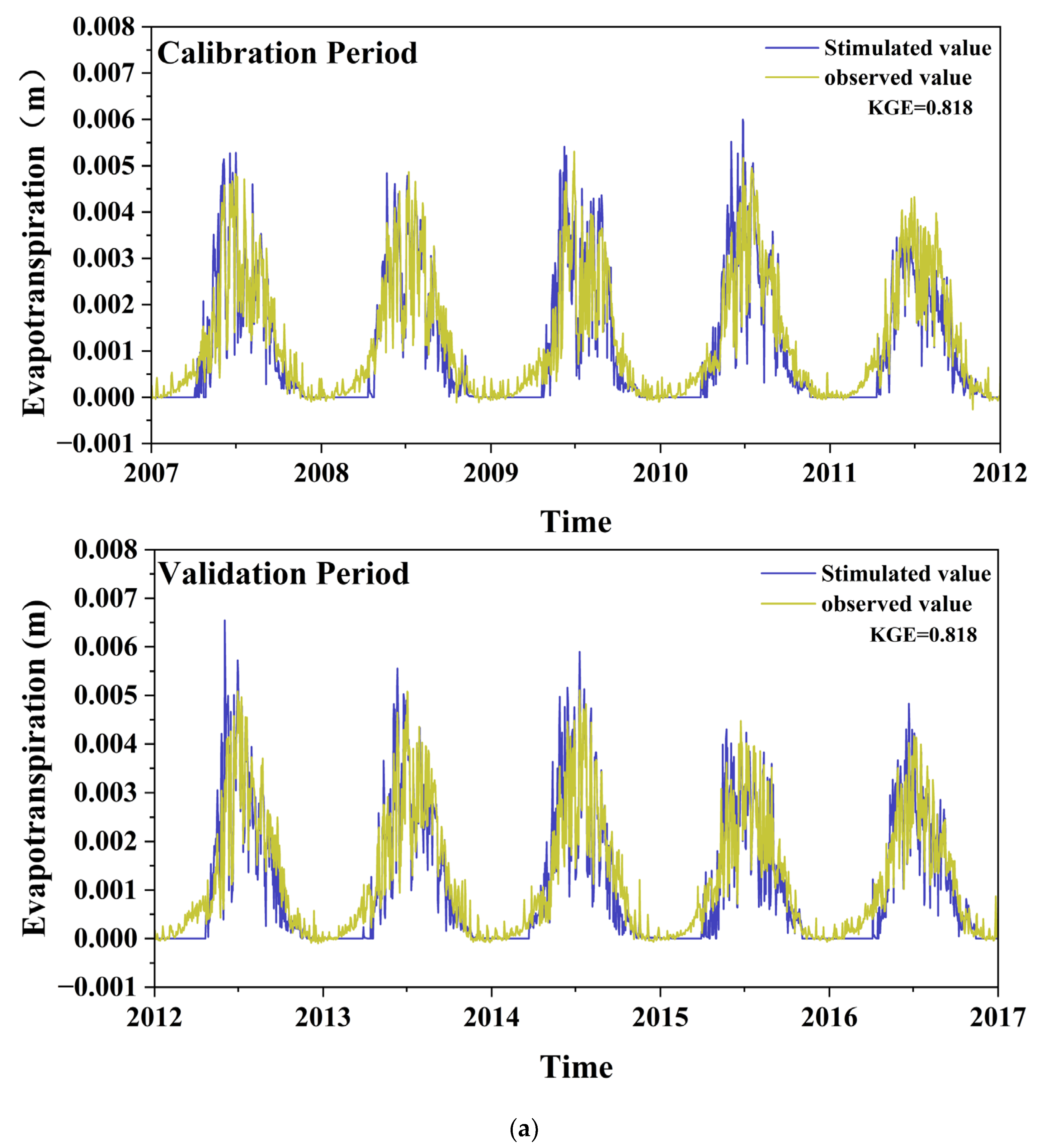

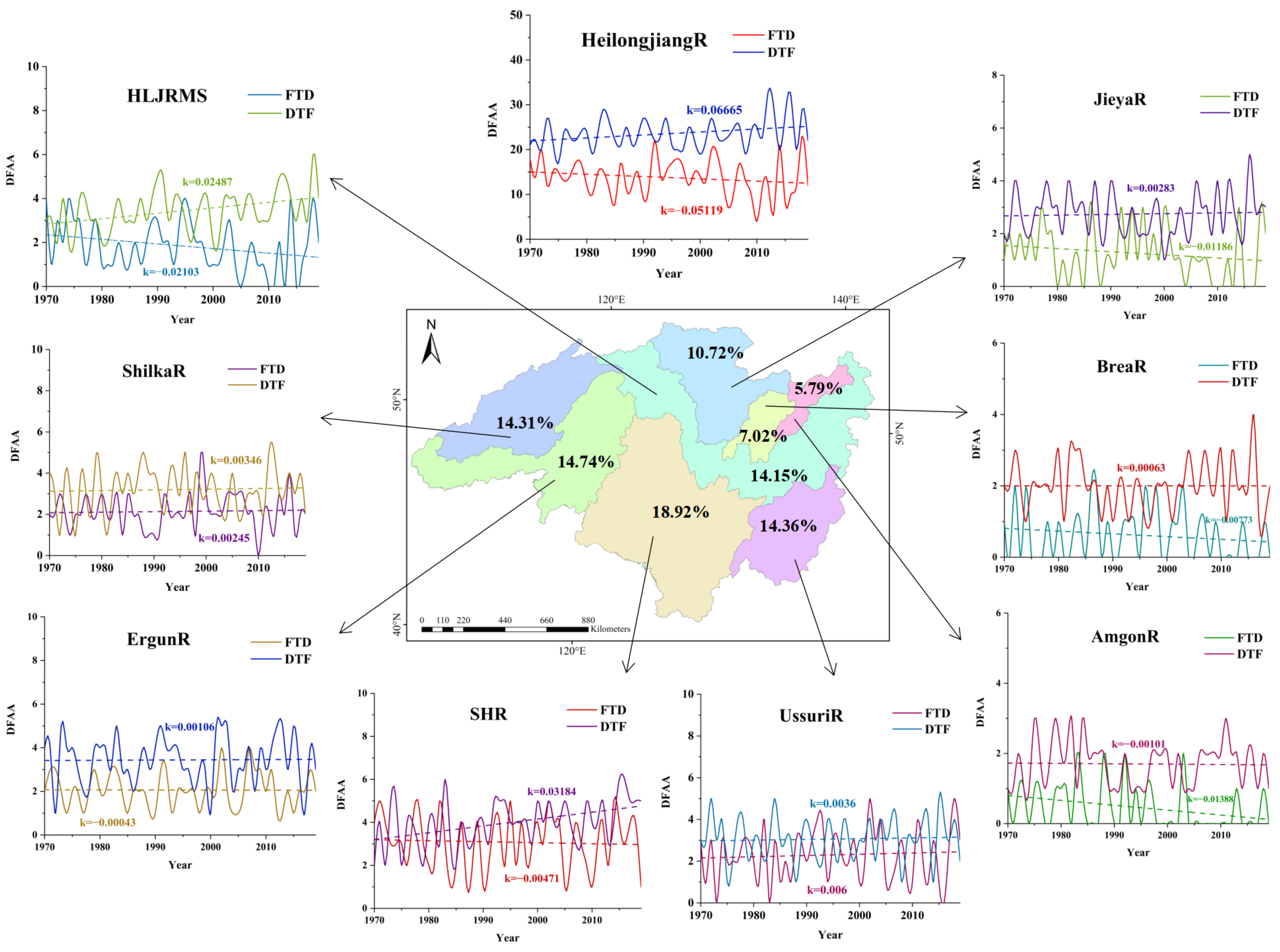

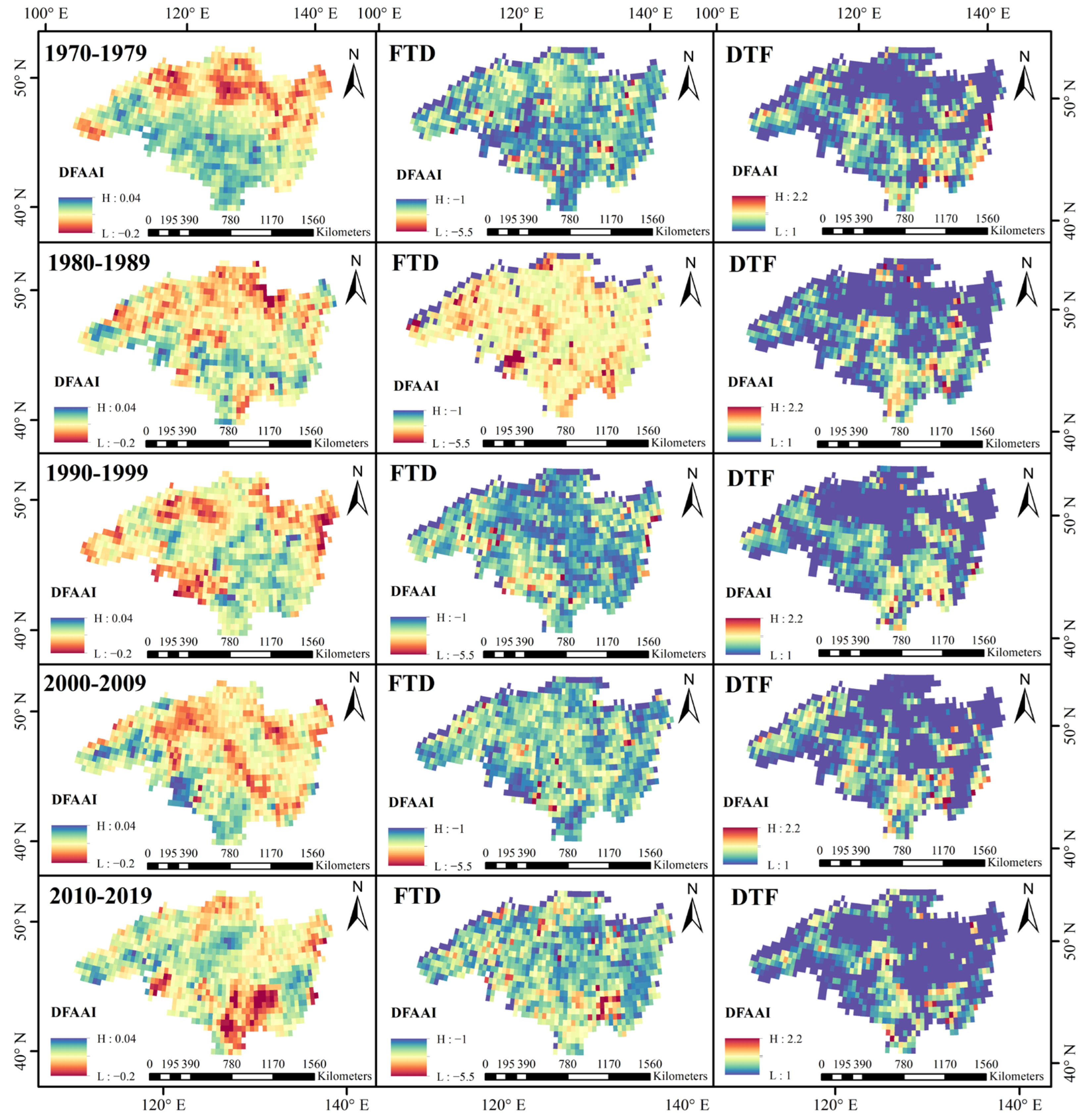
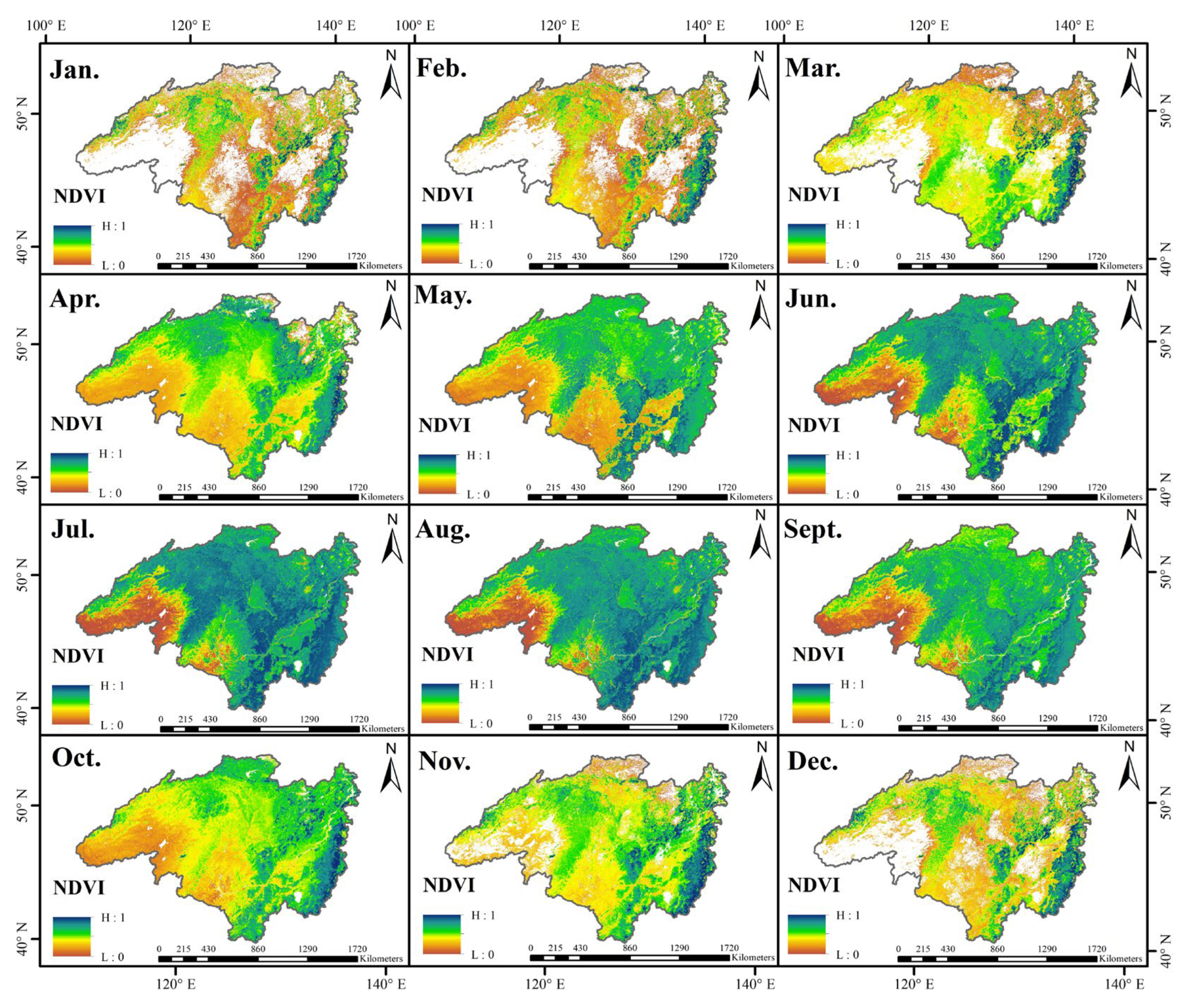

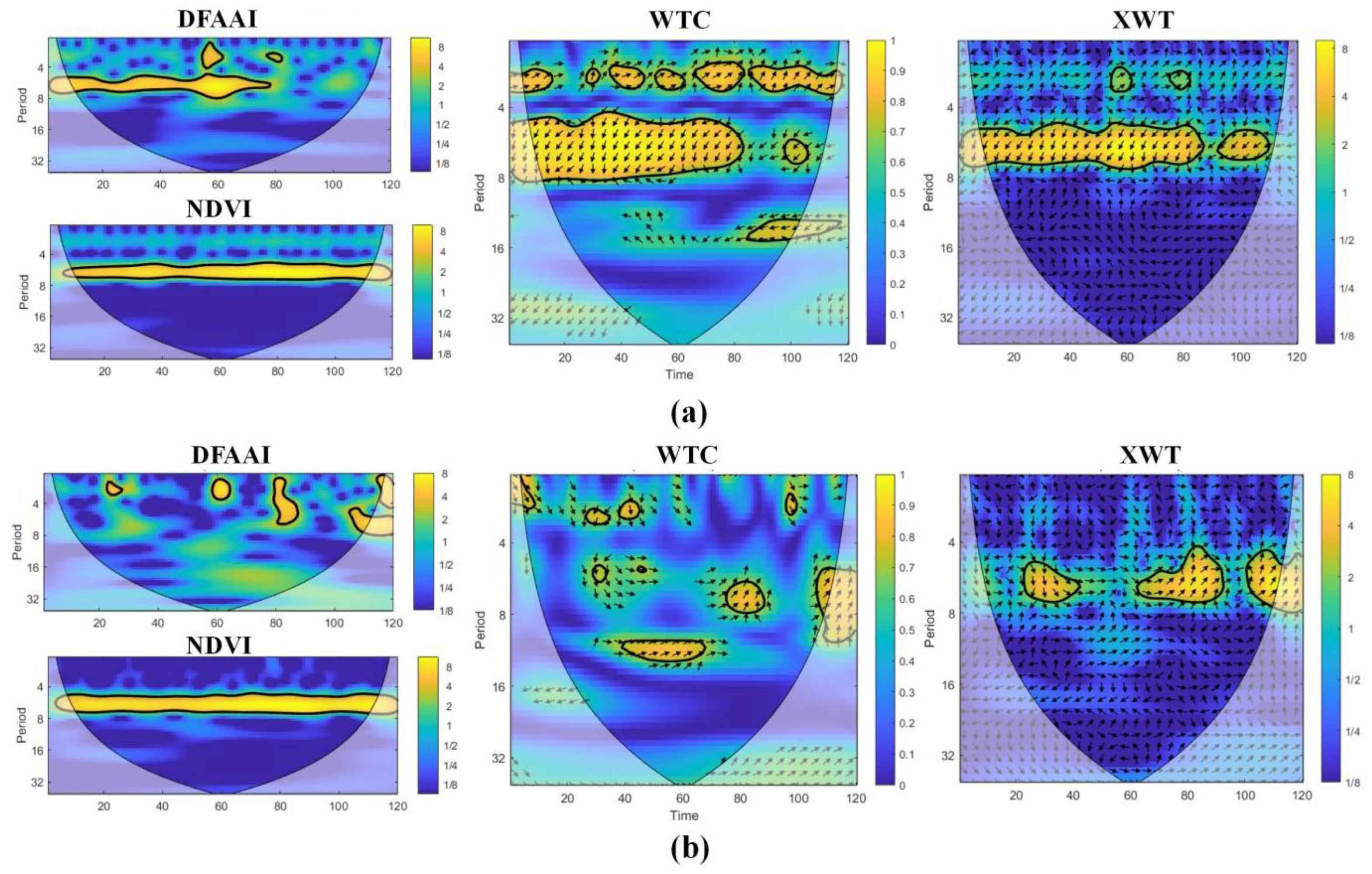

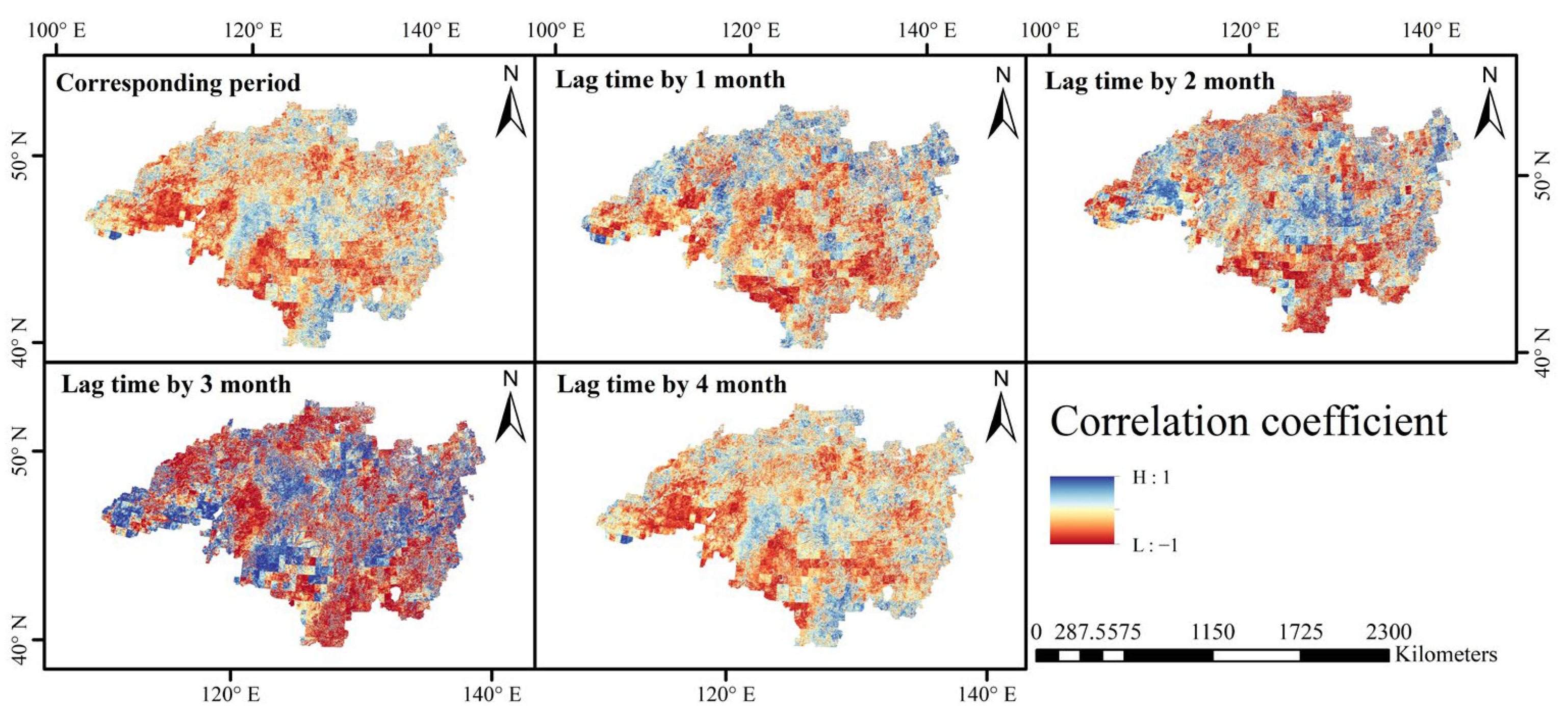
Disclaimer/Publisher’s Note: The statements, opinions and data contained in all publications are solely those of the individual author(s) and contributor(s) and not of MDPI and/or the editor(s). MDPI and/or the editor(s) disclaim responsibility for any injury to people or property resulting from any ideas, methods, instructions or products referred to in the content. |
© 2025 by the authors. Licensee MDPI, Basel, Switzerland. This article is an open access article distributed under the terms and conditions of the Creative Commons Attribution (CC BY) license (https://creativecommons.org/licenses/by/4.0/).
Share and Cite
Ma, H.; Jing, J.; Dai, C.; Xu, Y.; Qi, P.; Song, H. Spatiotemporal Dynamics of Drought–Flood Abrupt Alternations and Their Delayed Effects on Vegetation Growth in Heilongjiang River Basin. Water 2025, 17, 1419. https://doi.org/10.3390/w17101419
Ma H, Jing J, Dai C, Xu Y, Qi P, Song H. Spatiotemporal Dynamics of Drought–Flood Abrupt Alternations and Their Delayed Effects on Vegetation Growth in Heilongjiang River Basin. Water. 2025; 17(10):1419. https://doi.org/10.3390/w17101419
Chicago/Turabian StyleMa, Haoyuan, Jianyu Jing, Changlei Dai, Yijun Xu, Peng Qi, and Hao Song. 2025. "Spatiotemporal Dynamics of Drought–Flood Abrupt Alternations and Their Delayed Effects on Vegetation Growth in Heilongjiang River Basin" Water 17, no. 10: 1419. https://doi.org/10.3390/w17101419
APA StyleMa, H., Jing, J., Dai, C., Xu, Y., Qi, P., & Song, H. (2025). Spatiotemporal Dynamics of Drought–Flood Abrupt Alternations and Their Delayed Effects on Vegetation Growth in Heilongjiang River Basin. Water, 17(10), 1419. https://doi.org/10.3390/w17101419








